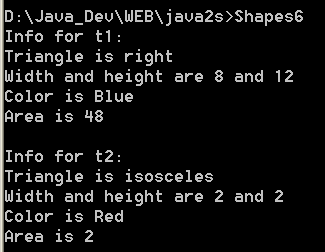A multilevel hierarchy 1

/*
C#: The Complete Reference
by Herbert Schildt
Publisher: Osborne/McGraw-Hill (March 8, 2002)
ISBN: 0072134852
*/
// A multilevel hierarchy.
using System;
class TwoDShape {
double pri_width; // private
double pri_height; // private
// Default constructor.
public TwoDShape() {
width = height = 0.0;
}
// Constructor for TwoDShape.
public TwoDShape(double w, double h) {
width = w;
height = h;
}
// Construct object with equal width and height.
public TwoDShape(double x) {
width = height = x;
}
// Properties for width and height.
public double width {
get { return pri_width; }
set { pri_width = value; }
}
public double height {
get { return pri_height; }
set { pri_height = value; }
}
public void showDim() {
Console.WriteLine("Width and height are " +
width + " and " + height);
}
}
// A derived class of TwoDShape for triangles.
class Triangle : TwoDShape {
string style; // private
/* A default constructor. This invokes the default
constructor of TwoDShape. */
public Triangle() {
style = "null";
}
// Constructor
public Triangle(string s, double w, double h) : base(w, h) {
style = s;
}
// Construct an isosceles triangle.
public Triangle(double x) : base(x) {
style = "isosceles";
}
// Return area of triangle.
public double area() {
return width * height / 2;
}
// Display a triangle's style.
public void showStyle() {
Console.WriteLine("Triangle is " + style);
}
}
// Extend Triangle.
class ColorTriangle : Triangle {
string color;
public ColorTriangle(string c, string s,
double w, double h) : base(s, w, h) {
color = c;
}
// Display the color.
public void showColor() {
Console.WriteLine("Color is " + color);
}
}
public class Shapes6 {
public static void Main() {
ColorTriangle t1 =
new ColorTriangle("Blue", "right", 8.0, 12.0);
ColorTriangle t2 =
new ColorTriangle("Red", "isosceles", 2.0, 2.0);
Console.WriteLine("Info for t1: ");
t1.showStyle();
t1.showDim();
t1.showColor();
Console.WriteLine("Area is " + t1.area());
Console.WriteLine();
Console.WriteLine("Info for t2: ");
t2.showStyle();
t2.showDim();
t2.showColor();
Console.WriteLine("Area is " + t2.area());
}
}
Related examples in the same category